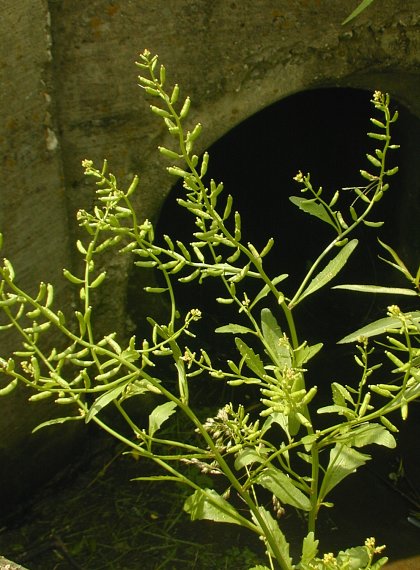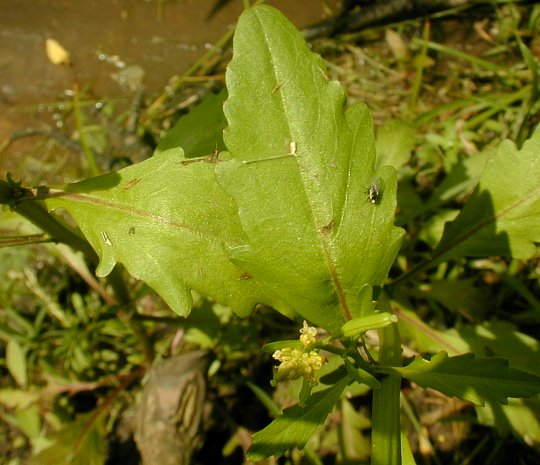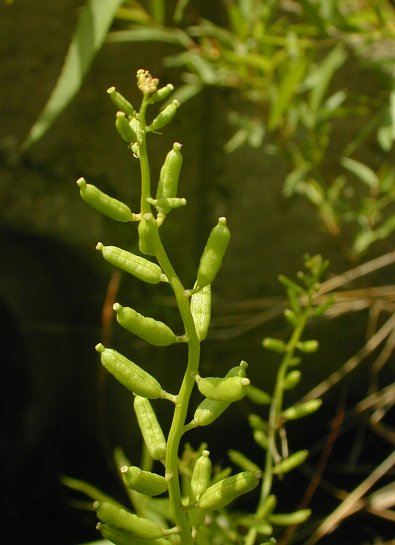Description: This plant is a winter or summer annual about 1-3' tall; it branches occasionally. The stems are light green and grooved. The alternate leaves are up to 5" long and 2" across, becoming smaller as they ascend the stems. The lower leaves are ovate or obovate, while the upper leaves are oblanceolate, elliptic, or oblong. The margins of these leaves have shallow pinnate lobes or they are broadly crenate. They taper gradually at the base and their tips are rather blunt. Both the stems and leaves are hairless. The upper stems terminate in slender racemes up to 1' long. These racemes are erect to ascending; the flowers bloom at the apex of each raceme, while the seedpods (siliques) develop below. The flowers are less than 1/8" across; they consist of 4 tiny yellow petals (or no petals), 4 yellowish green sepals, and a short pistil that is surrounded by several anthers. The pedicels of these flowers are 1/8" or less in length.

Plants that are
winter annuals bloom from late spring to mid-summer, while summer
annuals bloom from mid-summer to early fall. Individual plants can
remain in bloom for about 2-3 months. There is no noticeable floral
scent. Each flower is replaced by an oblongoid seedpod (silique) about
8 mm. (1/3") long that is shaped like a small sausage; it has neither a
stipe nor a beak. Each seedpod contains tiny seeds, which are
arranged in 2 rows. The seedpod splits open into 2 valves to release
the seeds. During cool fall weather, both the foliage and seedpods may
acquire a reddish color. The root system consists of a shallow
branching taproot. This plant reproduces by seeds only. It usually
doesn't form colonies.
Cultivation:
The preference is full or partial sun, wet conditions, and a soil that
is loamy, silty, or mucky. The size of individual plants varies with
the availability of moisture and soil fertility. This plant tolerates
standing water if it is temporary. Occasionally, it will sprawl or
topple over. This plant is rather weedy.

Range &
Habitat:
The native Sessile-Flowered Yellow Cress is occasional to common in
most areas of
Illinois; it is less common in northern Illinois and parts of southern
Illinois (see Distribution
Map). Habitats include openings in floodplain forests,
borders of ponds and rivers, drainage ditches along roads and
railroads, edges of flooded fields, degraded marshes, and soggy waste
areas. This plant is typically found in disturbed wetland areas; it
occupies many of the same habitats as Rorippa palustris
(Marsh Yellow Cress) and other Rorippa spp.
Faunal Associations:
The nectar and pollen of the flowers attract small bees and flies
primarily. Such visitors are not very common. Insects that feed
destructively on Sessile-Flowered Yellow Cress and other Rorippa spp.
include several flea beetles (Phyllotreta
spp.) and the False Cabbage Aphid (Lipaphis pseudobrassicae).
Apparently, the seedpods are little-used by birds and waterfowl as a
food source
and the foliage is rarely eaten by mammalian herbivores. The ecological
value of this plant to wildlife is rather low.

Photographic
Location:
The photographs were taken of plants growing along a drainage ditch in
Urbana, Illinois.
Comments:
This is one of the weedy members of the Mustard family that is native,
rather than introduced from Eurasia. While the flowers are
inconspicuous, the oblongoid seedpods become rather conspicuous after a
plant has been blooming for a month or two. Sessile-Flowered Yellow
Cress is rather similar in appearance to Rorippa palustris
(Marsh Yellow Cress), although the latter has slightly showier flowers
and it tends to branch more. The distinctive feature of
Sessile-Flowered Yellow Cress consists of the short pedicels of the
flowers/seedpods – these pedicels are 1/8" in length or less, and they
are much shorter than the seedpods. The pedicels of Marsh Yellow Cress
are about 8 mm. (1/3") in length, and they are about the same length as
the seedpods. Other Rorippa spp. also have showier
flowers with longer pedicels, and their leaves are often more deeply
lobed.